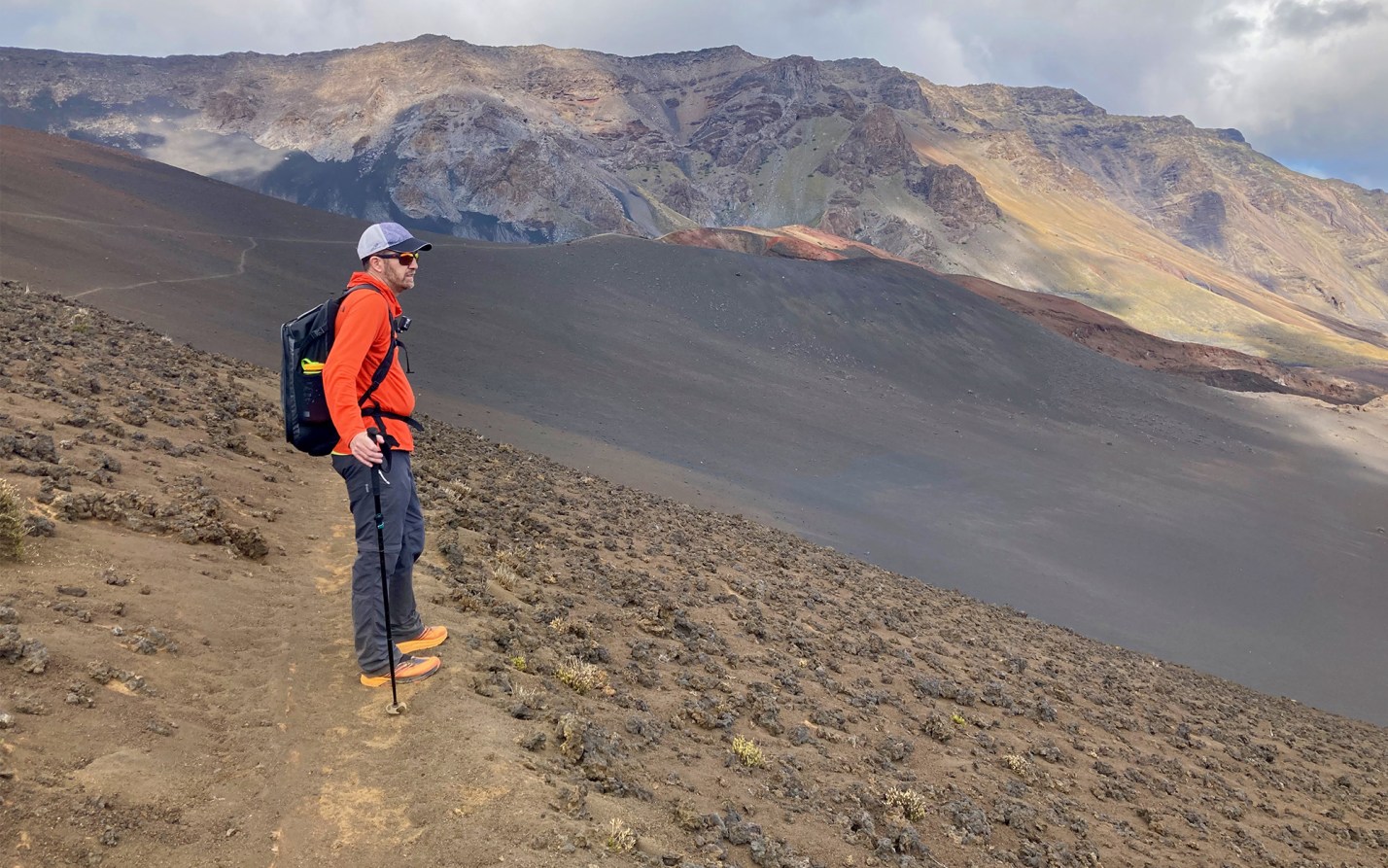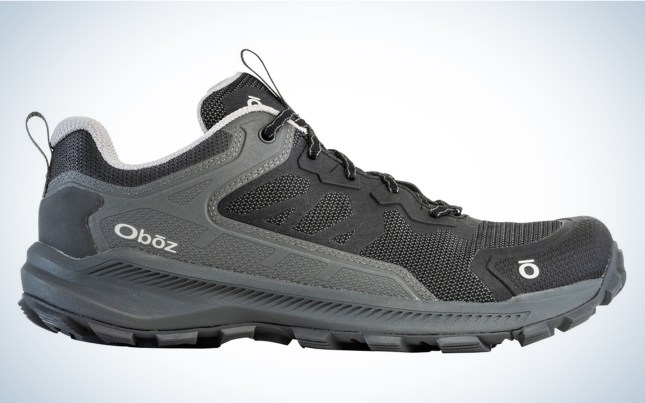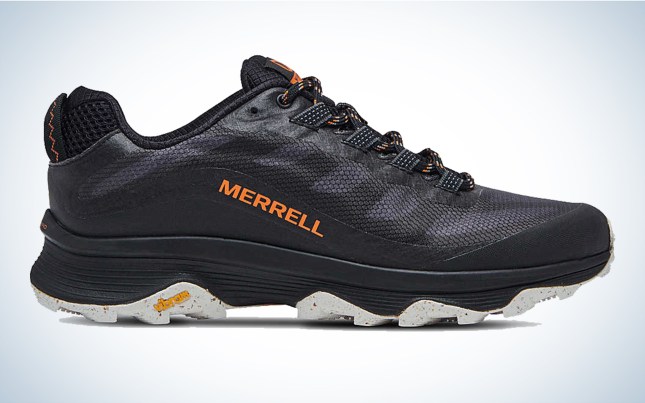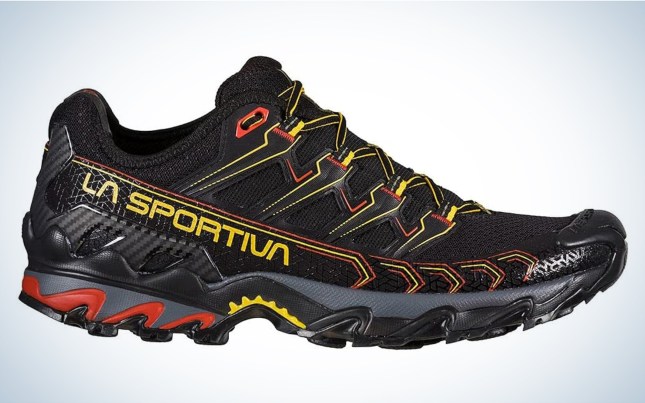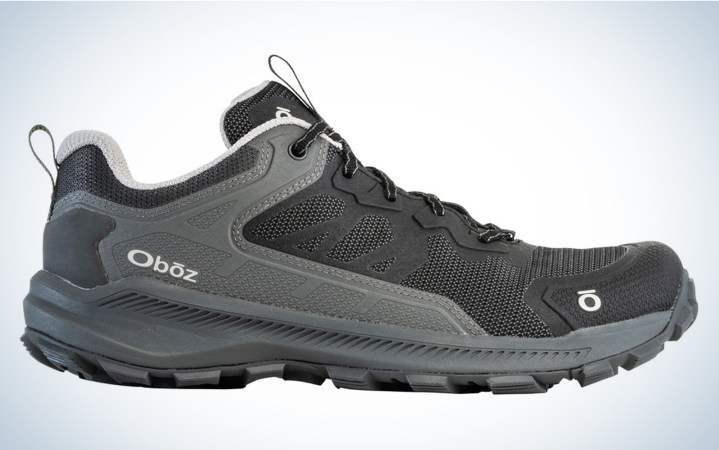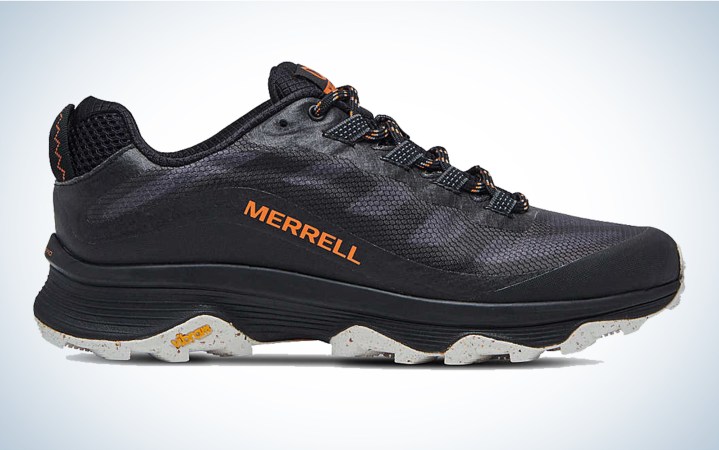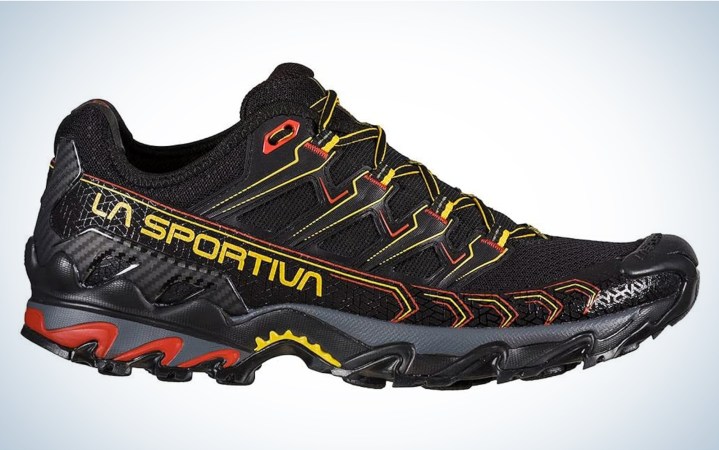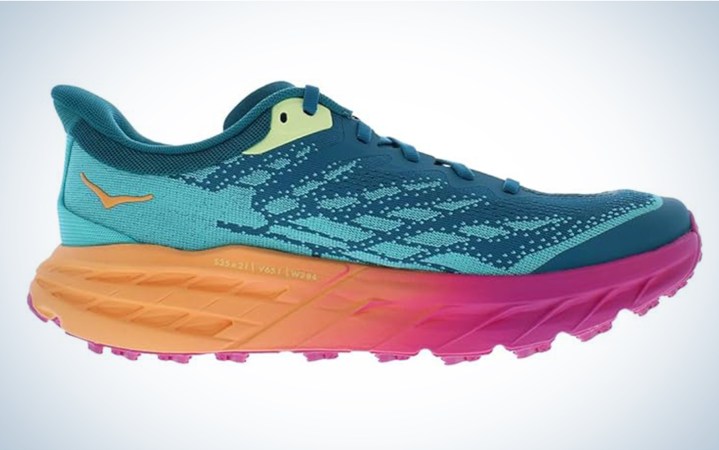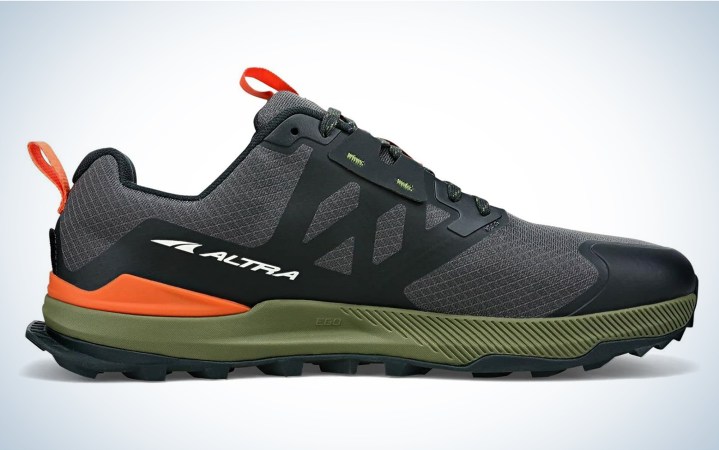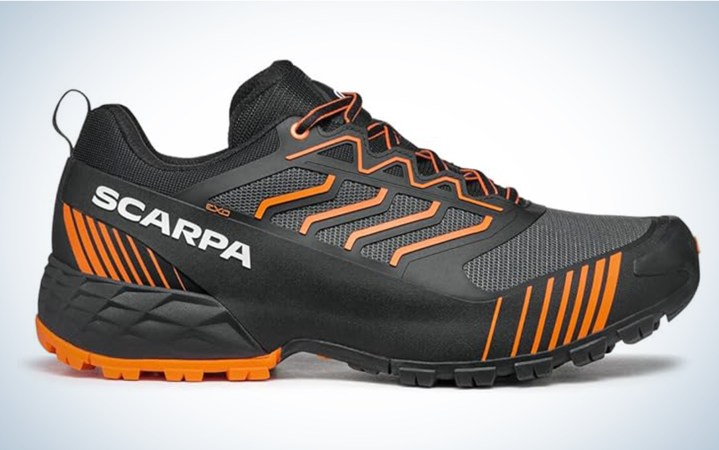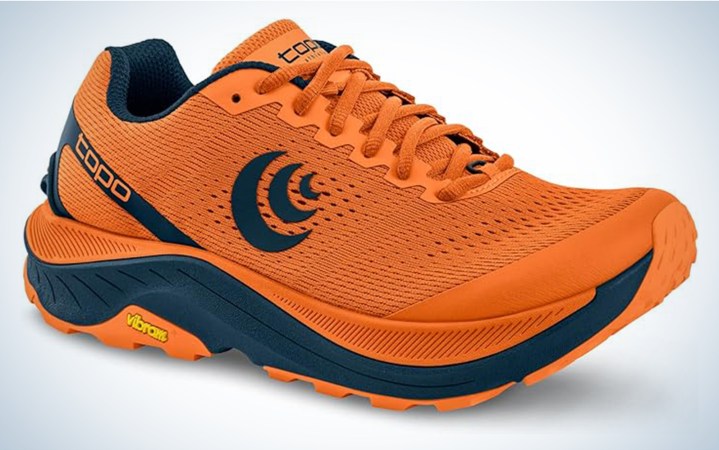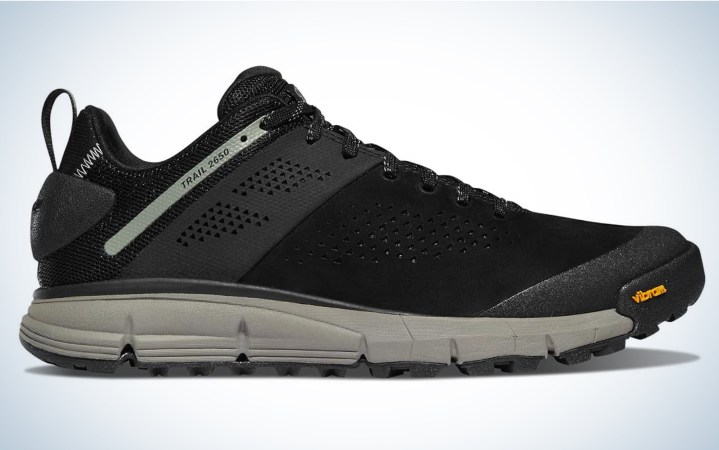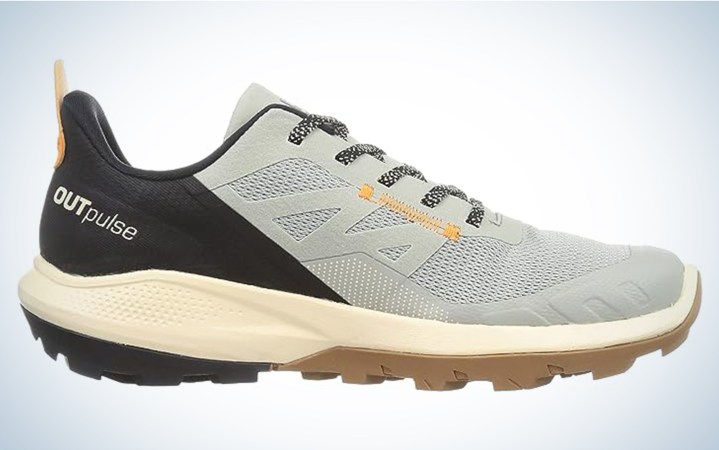We may earn revenue from the products available on this page and participate in affiliate programs. Learn More ›
As a backcountry guide in Alaska, taking care of my feet with proper footwear is as important as taking care of my health. My feet are my job’s lifeline. I lean toward hiking boots for Alaska’s trail-less backcountry. Yet, I wear lightweight hiking shoes anytime I know I’ll be on established trails, and especially when traveling and hiking in any other state besides Alaska.
- Best Overall: Oboz Katabatic
- Best Budget: Merrell Moab Speed
- Best for Wet Conditions: La Sportiva Ultra Raptor II
- Best Bounce: Hoka Speedgoat 5
- Best for Trail Running: Altra Lone Peak 7
- Most Durable: Scarpa Ribelle Run XT
- Most Comfortable: Topo Ultraventure 3
Best of the Rest
How I Tested the Best Lightweight Hiking Shoes
For this piece, I first surveyed my experience, relying on the brands and models I’ve used over the years. For example, my wife and I put 1,000 miles on our first pairs of Merrell Moabs for our Appalachian Trail thru hike, followed by another 1,000 miles on a second pair each. At that time, in 2011, they were in the lightweight category. Since then, the Merrell Moab line’s upgrades still offer the same durability and support in a lighter weight. And even though I normally wear boots while guiding, I tested many lightweight models against the harsh Alaska backcountry.
I also relied heavily on the expertise of Kim Kelley, a footwear specialist at REI. Her 15 years of experience and input about best sellers was invaluable.
Best Lightweight Hiking Shoes: Reviews & Recommendations
Best Overall: Oboz Katabatic
Best All Around
Oboz Katabatic
Key Features
- Men’s and women’s specific models
- Weight Per Shoe: 12.7 ounces (men’s), 9.8 ounces (women’s)
- Available Sizes: 8-14 (men’s) and 5-12 (women’s)
- Four color options
Pros
- Non-waterproof and waterproof options ($20 more)
- Mid-ankle option available
- Breathable mesh
Cons
- No wide options
- Not a Vibram outsole
- Weight
To be honest, this was my first time trying Oboz. I hear so many people rave about the brand, the quality, and the comfort, but I finally tried out the Katabatic Lows to see about the hype. What did I discover? Out-of-the-box comfort and no rub spots after over 100 miles. The unique construction of abrasion-resistant, breathable mesh with plastic rubber molds the shoe around the foot for better protection and support. “They are the only company that adds a molded hard plastic insole to their shoes for real arch support that will not quickly squish down under pack weight or a foot that habitually overpronates. It’s like getting aftermarket insoles for free in every pair,” Kelley says.
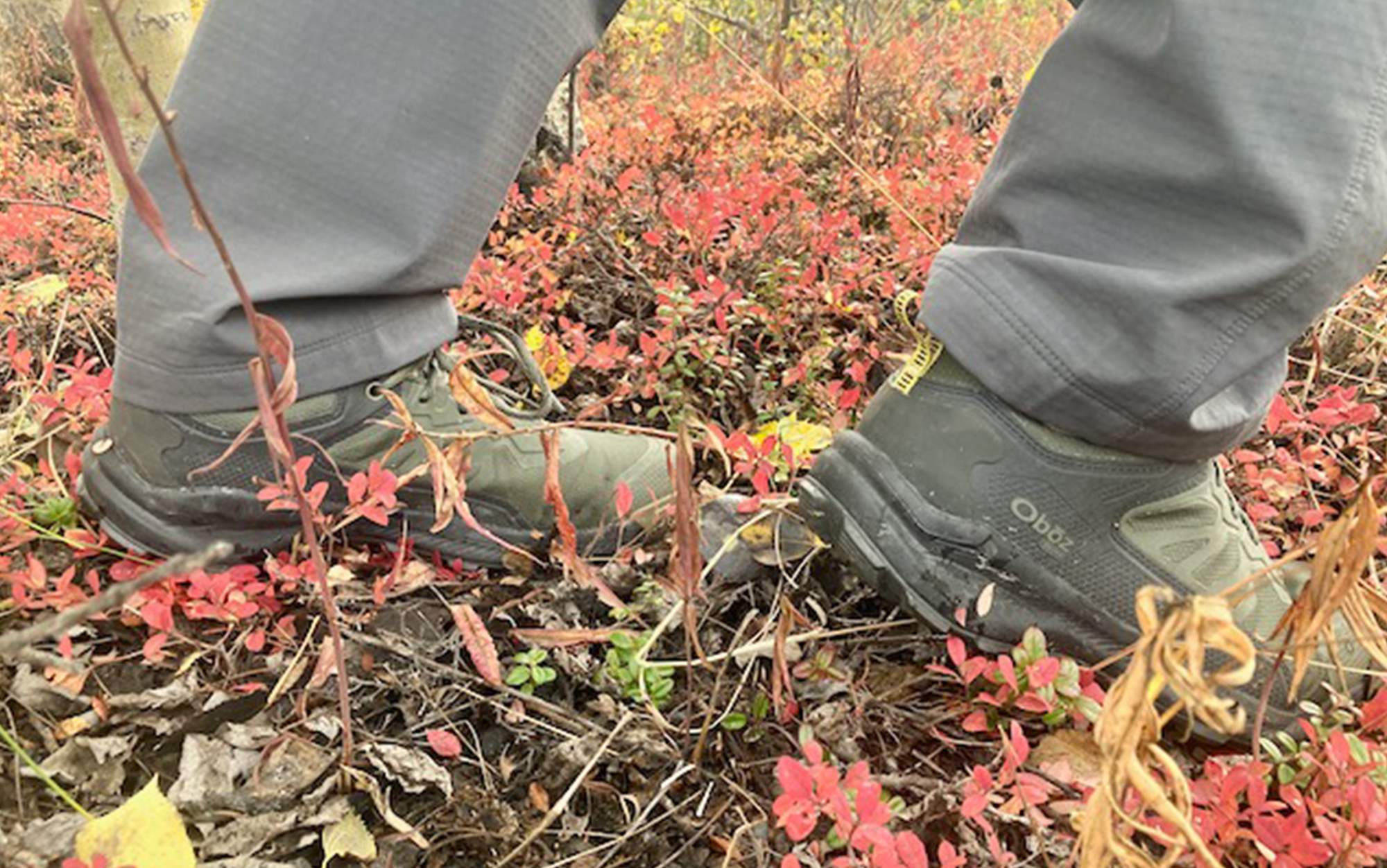
While they don’t utilize a Vibram outsole, Oboz does have their own Trail Tread, which has an aggressive multidirectional lug pattern comparable to Vibram outsoles. I always kept my grip, even on wet, rocky, and rooted trails. Its relatively low heel-to-toe drop of 8mm gives a nice sense of stability to this shoe as well.
Green bonus: They are designed in Bozeman, Montana, and Oboz will plant a tree for every pair of shoes sold.
Best Budget: Merrell Moab Speed
Best Budget
Merrell Moab Speed
Key Features
- Men’s and women’s specific models
- Weight Per Shoe: 9.2 ounces (men’s), 8.5 ounces (women’s)
- Available Sizes: 7-15 (men’s), 5-11 (women’s), and kids’ sizes available
- Four color options for women’s, Five for men’s
Pros
- Non-waterproof and waterproof options ($30 more)
- Wide width available for both male and female
- Affordable regular price ($130), but often on sale
Cons
- White color choice gets dirty quickly
- Hard to fit to your feet
I remember when my wife and I were prepping for our thru hike of the Appalachian Trail in 2011, we not only consulted gear guides, but also perused the shelves of REI for the best pair that would give us the most support and last the longest. The go-to brand that year was Merrell, so that’s what we chose, specifically Merrell Moabs. After over 2,000 miles and two pairs, our feet were happy with our choice.
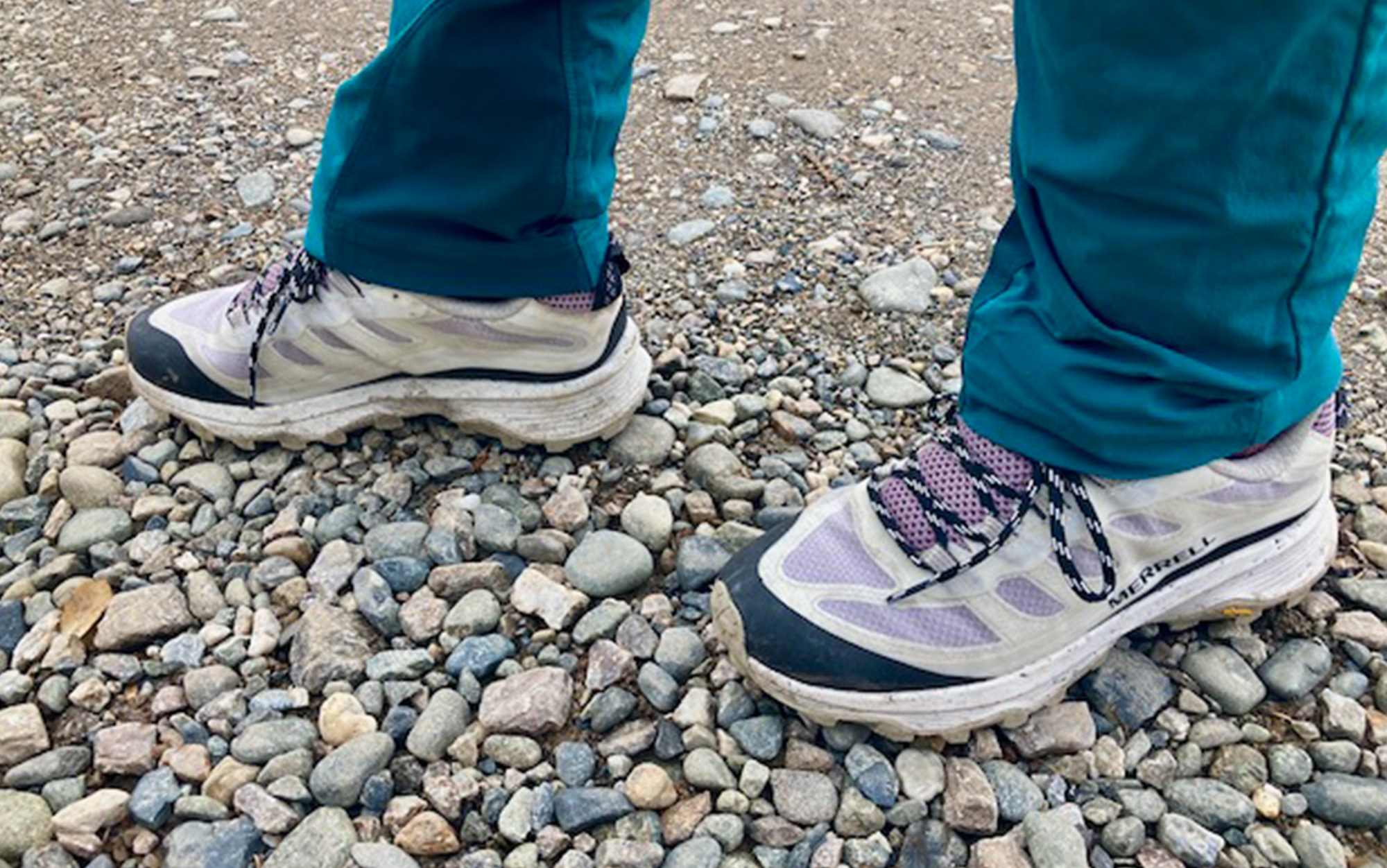
The newest rendition of the Moab Speeds steps up the game with its Vibram outsole that now relies on partially recycled rubber, as well as the 4mm traction lugs. The bellowed tongue truly keeps out debris, a huge plus as most of the hiking we do in Alaska through the willows and alders, so low-top shoes typically gather hitchhiking plants.
They are often on sale, and at the time this article went to print, they were $40 off MSRP. But even at the regular price of $130, these shoes are an ideal price for the durability they deliver. Bonus: They are vegan, so now I’m wondering, can you eat them?
Best for Wet Conditions: La Sportiva Ultra Raptor II GTX
Best for Wet Conditions
La Sportiva Ultra Raptor II GTX
Key Features
- Men’s and women’s specific models
- Weight Per Shoe: 14.1 ounces (men’s), 12 ounces (women’s)
- Available Sizes: 6-15.5 (men’s) and 5-11 (women’s)
- Leather option
Pros
- Waterproof Gore-Tex protection
- Non-waterproof option available
- Wide options are available for men and women
Cons
- Expensive
- Only one color option
- Not true to size
I wrote about the La Sportiva Ultra Raptor II Mid GTX for “The Best Hiking Boots for Men,” and echo the same accolade of protection from the elements for these low version.
Similar to the mid-ankle version, the stiff rubber that makes up the raised grippy lugs is very tacky on slick surfaces. Kelley did note that she tends to see these lugs wear down quicker on harder surfaces and talus-type surfaces like granite.
Although all the shoes in the test come in a waterproof version, these stood out because of their Gore-Tex shield material, but they breathe very well too. I wore these on several wet frontcountry trails, and with gaiters, my entire foot stayed completely dry after a full day of hiking in the pouring rain. Pro tip: I would go a half size up.
Best Bounce: Hoka Speedgoat 5
Best Bounce
Hoka Speedgoat 5
Key Features
- Men’s and women’s specific models
- Weight Per Shoe: 10.3 ounces (men’s), 8.5 ounces (women’s)
- Available Sizes: 7-15 (men’s and women’s)
- 17 color options for women, 15 color options for men
- Wide options available
Pros
- Lots of cushion
- Plethora of color options
- Winterized option available
Cons
- Outsole can deteriorate quickly on rocky surfaces
- Bounce in step minimizes ground contact
Hoka took the world by a storm, and nowadays, it’s hard not to spot the brand among thru-hikers and grandmas alike. Known for their extreme softness, springy bounce, and thick outsole support, they have a distinct moon shoe look, but it’s worth the comfort.
Categorized as a trail runner, they do bridge the gap to a lightweight hiker. For two years, I have been loving (and abusing) my Speedgoat 4s. I am on board with the comfort. In fact, this is the first shoe I didn’t need to replace the manufacturer’s insole with an aftermarket one. However, after hiking about 50 miles on lava rock in Hawaii, my Vibram lugs look like my dog chewed them off. The newest version are a ½ ounce lighter and have added traction making them even better.
Best for Trail Running: Altra Lone Peak 7
Best for Trail Running
Altra Lone Peak 7
Key Features
- Men’s and women’s specific models
- Weight Per Shoe: 11 ounces (men’s), 9.2 ounces (women’s)
- Available Sizes: 7-16 (men’s) and 5.5-12 (women’s)
- Eight color options
Pros
- Lightweight
- Wide toe box
Cons
- No wide options
- No ideal for carrying heavy loads
If you look at any trail runner and/or ultralight hiker, this is what they are wearing. Even Kelley claimed based on REI’s trends, this is the “hottest trail running shoes” out there.
It has a wide, rounded toe box that offers great comfort and space for your foot’s metatarsals to splay out, naturally absorbing the impact of your foot landing. The toes are usually scrunched in most other shoes from a pointier toe box.
Thanks to the zero drop from the forefoot to heel, trail runners achieve a mid or forefoot landing, which encourages a more stable gait and connectivity to the ground.
However, Kelley claims the downside is that “they offer little in the way of medial support, and using them for longer distances or weight bearing is a ticket for foot injuries such as plantar fasciitis.” She advised adding an aftermarket insole such as Superfeet to it if doing higher mileage or carrying any more than 10 or 15 pounds on a day hike.
READ NEXT: Altra vs Hoka
Most Durable: Scarpa Ribelle Run XT
Most Durable
Scarpa Ribelle Run XT
Key Features
- Men’s and women’s specific models
- Weight Per Shoe: 12.5 ounces (men), 10.4 ounces (women’s)
- Sizes: 7.5-14 (men’s) and 5-10 (women’s)
- One color option
Pros
- Durable
- Grippy outsole
Cons
- One color option
- No large options
- Expensive
These might push the boundaries in the lightweight hiking shoe category, but they are the most durable of the test. I have been wearing Scarpa boots and shoes for years both on the trail and while mountaineering. The newer Ribelle Run XT looks like a traditional hiker shoe, but has a 6mm drop with a midsole that gives you more stability. This means the shoe really reacts well to the terrain, allowing push and braking with curved lugs that offer grip, especially on rocky surfaces.
Most Comfortable: Topo Ultraventure 3
Most Comfortable
Topo Ultraventure 3
Key Features
- Men’s and women’s specific models
- Weight Per Shoe: 10.2 ounces (men’s), 8.3 ounces (women’s)
- Available Sizes: 8-13 (men’s) and 6-11 (women’s)
- Three color options
Pros
- Wide toe box
- Great cushion and fit
Cons
- No wide options
- Mesh can tear easily
Similar to Alta, Topo is another company making some noise in the lightweight hiking and trail running community with their low heel-to-toe drop and wider toe box. These are OL assistant gear editor’s favorite and she recently wrote about them here.
As another testament to their cushion, comfort, and support, New Hampshire tester Kristen Coats has a neuroma in her foot, but said with Topo’s larger toe box, her nerve tissue does not get inflamed.
“After trying a dozen other brands, and finding some that worked, I tried the Topo brand and haven’t looked back,” she says. “I can finally run on trails and roads pain-free, and have bagged many peaks all over the world with Topo. In fact, I recently ran my best half-marathon and 5K race in my Topos.”
Best of the Rest
Danner Trail 2650
Danner Trail 2650
Key Features
- Men’s and women’s specific models
- Weight Per Shoe: 12 ounces (men’s), 9 ounces (women’s)
- Sizes: 7-14 (men’s) and 5-11 (women’s)
- Nine color options women, seven for men
- Wide option for men only
Pros
- Waterproof option available ($20 more)
- Quality craftsmanship
Cons
- Expensive
- Tend to run very narrow
These shoes are so stylish, you could go from trail to a formal dinner. Wrapped with a soft suede leather and a mesh breathable lining, they are ideal for exposed hiking conditions. The Vibram outsole is very grippy both in wet and dry conditions. Our guide tester loved the moderate stiffness of the suede for support while scrambling up rocky terrain.
Salomon Outpulse
Salomon Outpulse
Key Features
- Men’s and women’s specific models
- Weight (per shoe): 11.5 ounces (men’s), 9.9 ounces (women’s)
- Sizes 7-14 (men’s) and 5-12 (women’s)
- Two color options
Pros
- Affordable
Cons
- Narrow fit
- Narrow treads catch stones
I initially planned to test the Salomon’s Outpulse Mids for “The Best Hiking Boots for Men” article, but the samples arrived too late. Now after wearing both the mid and low models, they offer great value combining comfort and stability on mixed terrain. They are also one of the least expensive models on the list. The multidirectional lugs offer great grip—almost too much. They are narrow and collect small stones along hikes. Salomon does tend to run narrow, especially in the midfoot area and the heels.
Things to Consider Before Buying the Best Lightweight Hiking Shoes
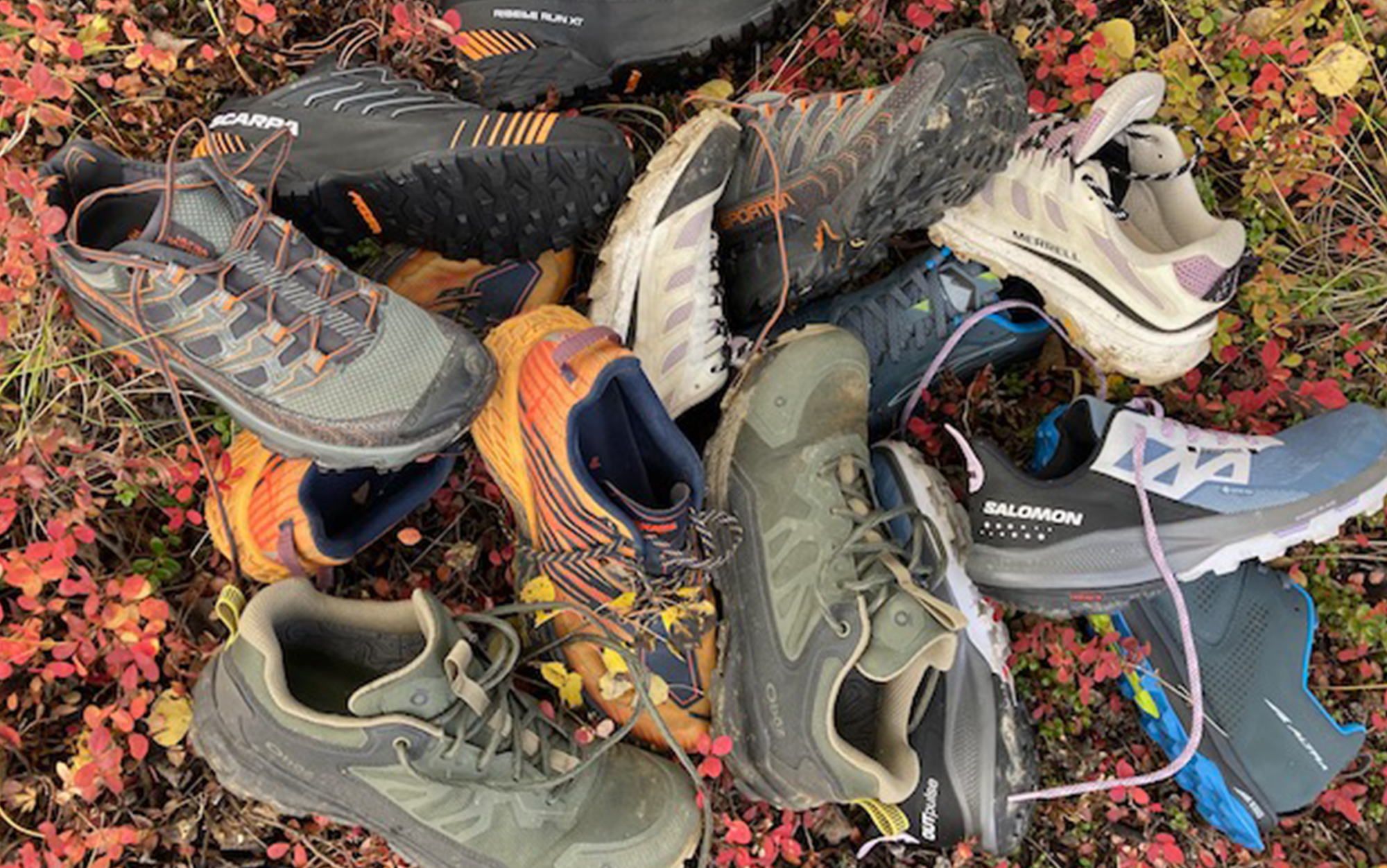
Perhaps the first question you need to answer is do I need a hiking boot, trail runner, or hiking shoe? Take a more detailed look at this article. Although some are good for both, I mainly focused on lightweight hiking shoes that would bridge the gap between hiking boots and trail runners. See the FAQs to learn a bit more about the differences between each.
Drop
The heel-to-toe drop is the difference in the height from the forefront to the heel. So a greater drop means there is a steeper angle and less stability. A zero drop means the heel touches the ground at the same time as the forefront, which offers a stable landing and ideal connectivity with the ground.
Weight
We are not talking in pounds when we reference lightweight hiking shoes; we reserve that for hiking boots. But certain features of shoes can add to the weight, like the outsole and weather protection (like waterproofing). Most of these lightweight hiking shoes offer a waterproof and non-waterproof model, and you can see a difference in their weights. Also, the lighter the shoe, the less likely you can carry more of a weight load.
Outsoles
Usually, every outsole looks different. The shape, size, direction, and depth of the lugs are what assist in traversing mud, dirt, rocks, ice, and snow. Also, Vibram is the most common material type, but there were a few different compositions in this test.
Insoles
Most boots are made with an EVA foam insole. It is a soft material that absorbs some of the impact of your step. It sounds great in theory, but most of that foam is very thin and actually absorbs very little impact. The flimsy factory insoles break down quickly and tend to get dirty and smelly. In most cases, I upgrade my insoles with an aftermarket brand, like Superfeet. These insoles are made to better cushion and cradle your feet with zone-specific areas that offer superior support and comfort.
FAQs
Trail runners are more minimalist in features than hiking shoes. Trail runners carry a lighter load, are lighter in weight, and are typically more breathable. Hiking shoes, on the other hand, can carry heavier loads, provide a bit more support and stability, tend to have more traction, and are typically warmer than a trail runner.
Fit and comfort are probably more important than weight, but it is a personal preference. You want to reduce any way you can get foot fatigue and having something too heavy on your foot can cause that. The shoes in this test ranged from 8 to 14 ounces, so they are definitely in a lighter weight class than hiking boots. Trail runners should be less than a pound per shoe, and hiking shoes should be less than two pounds per shoe.
You can certainly hike in whatever you want, but sneakers are probably not the best choice. Hiking-specific shoes tend have more features, like a beefy, supportive outsole with multidirectional lugs that provide grip on rocky, wet and uneven surfaces. Hiking shoes can also be waterproof, while most sneakers are not, which can give you blisters, and take a long time to dry out.
Final Thoughts
As a child, I hated the agonizing task of shoe shopping with my mom. These days, I am stoked on the variety of options available and find that different shoes fit my different needs. As I said, I am a guide in Alaska, who logs hundreds of miles on rough terrain usually in boots. But when I know I am hitting established trails, I want to ditch some of the weight and opt for lightweight hikers.
- Best Overall: Oboz Katabatic
- Best Budget: Merrell Moab Speed
- Best for Wet Conditions: La Sportiva Ultra Raptor II
- Best Bounce: Hoka Speedgoat 5
- Best for Trail Running: Altra Lone Peak 7
- Most Durable: Scarpa Ribelle Run XT
- Most Comfortable: Topo Ultraventure 3
Best of the Rest
